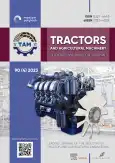Comparison of different blade shapes of translatory moving soil tillage tools
- Authors: Kudzaev A.B.1
-
Affiliations:
- Gorsky State Agrarian University
- Issue: Vol 90, No 4 (2023)
- Pages: 337-349
- Section: Theory, designing, testing
- URL: https://bakhtiniada.ru/0321-4443/article/view/232081
- DOI: https://doi.org/10.17816/0321-4443-321315
- ID: 232081
Cite item
Full Text
Abstract
BACKGROUND: The efficiency and energy capacity of translatory moving soil tillage tools are largely determined by the parameters of their blades. If the parameters do not match the specified operating conditions, clogging the working tools with plant residues becomes possible, and a less energy-consuming type of soil cutting — sliding — may be replaced with a more energy-consuming type — chopping cutting. In this regard, it is very important for scientists engaged in improving the designs of translatory moving soil tillage tools to have a method for assessing the shape of the blades.
AIMS: Development of a method for comparative assessment of various blade shapes of translatory moving soil tillage tools.
METHODS: For this study, the fundamentals of agricultural mechanics, higher mathematics, and theoretical mechanics were used. The objects of the study were the blades of various soil tillage tools, providing with sliding cutting of soil. The study was conducted at the Gorsky State Agrarian University in the period from 2022 to 2023. The calculations results were compared with the materials of the corresponding standards.
RESULTS: The method that helps to determine the relative values and directions of the resultant force of soil cutting resistance with a translatory moving blade of a soil tillage tool having a diverse shape has been developed. An example of the application of the method for assessment the effectiveness of blades of a garden tool, the cutting part of which is described by the equation of a straight line, a circle, an Archimedes spiral, a logarithmic spiral, as well as an example of assessment of a curved blade for soil tillage tools of cultivators are given.
CONCLUSIONS: The proposed method for assessing the influence of the shape of a translatory moving flat blade of the soil tillage tools on the value of soil cutting resistance forces is easy to use and can be the basis for further development in order to analyze the effectiveness of the knives’ blade shape performing a plane-parallel movement.
Full Text
##article.viewOnOriginalSite##About the authors
Anatoliy B. Kudzaev
Gorsky State Agrarian University
Author for correspondence.
Email: akudzaev@rambler.ru
ORCID iD: 0000-0001-5973-9932
Dr. Sci. (Tech), Professor of the Technical Systems in Agribusiness Department
Russian Federation, VladikavkazReferences
- Milling knives and rotary teeth. Catalog of the company “INDUSTRIEHOF Scherenbostel”. Accessed: 28.02.2023. Available from: https://www.industriehof.com/ru/catalogue/c2/c10/
- Sakai J. Theoretical Approach to the Hand Tractor of Rotary Tillage. JARQ. 1974;8(3):153–158. Accessed: 28.02.2023. Available from: https://www.jircas.go.jp/sites/default/files/publication/jarq/08-3-153-158_0.pdf
- Sakai J. Designing Process and Theories of Rotary Blades for Better Rotary Tillage (Part 1). JARQ. 1978;12(2):86–93. Accessed: 28.02.2023. Available from: https://www.jircas.go.jp/sites/default/files/publication/jarq/12-2-086-093_0.pdf
- Sakai J, Shibata J, Tagushi T. Design Theory of Edg-Curves for Rotary Blades of Tractors. Journal of the Japanese Society of Agricultural Machinery. 1976;38(2):183–190. doi: 10.11357/jsam1937.38.183
- Ju J-S, Luan J-M, Cheng C-W. Trajectory Angles and Cultivating Dynamics for Tiller Blades. Journal of Agricultural Machinery. 2004;13(1):1–15. doi: 10.30062/JAM.200403.0001
- Ghosh BN. The power requirement of a rotary cultivator. Journal of Agricultural Engineering Research. 1967;12(1):5–12.
- Gupta CP, Visvanathan R. Dynamic behavior of saturated soil under impact loading. Trans. ASAE. 1991;36(4):1001–1007.
- Mandal SK, Bhattacharyya B, Mukherjee S, et al. Design Optimization of Rotary Tiller Blade using Specific Energy Requirement. International Journal of Current Engineering and Technology. 2016;6(4):1257–1263. doi: 10.14741/Ijcet/22774106/6.4.2015.31
- Marenya MO. Performance characteristics of a deep tilling rotavator [Internet]. Pretoria: University of Pretoria; 2009. Accessed: 28.02.2023. Available from: https://repository.up.ac.za/bitstream/handle/2263/25458/Complete.pdf?sequence=7&isAllowed=y
- Goryachkin VP. Theory of straw cutters and silage cutters. Collected works: in 3 vols. Moscow: Kolos; 1968;3:68–113. (in Russ).
- Goryachkin VP. The theory of hand scissors and the basic principles of their construction. Collected works: in 3 vols. Moscow: Kolos; 1968;3:120–133. (in Russ).
- Panov IM. Mekhaniko-tekhnologicheskie osnovy rascheta i proektirovaniya pochvoobraba-tyvayushchikh mashin s rotatsionnymi rabochimi organami [dissertation] Moscow; 1983. (in Russ).
- Kanarev FM. Rotary tillage machines and implements. Moscow: Mashinostroenie; 1983. (in Russ).
- Sineokov GN. Design of tillage machines. Moscow: Mashinostroenie; 1965. (in Russ).
- Alekseev AI. Obosnovanie parametrov frezy dlya obrabotki pochvy k posadke kartofe-lya [dissertation] Moscow; 2021. (in Russ).
- Dranyaev SB, Chatkin MN, Koryavin SM. Modeling the operation of a screw L-shaped knife of a tiller. Tractors and Agricultural Machinery. 2017;84(7):13–19. (in Russ). doi: 10.17816/0321-4443-66315
- Gadzhiev PI, Slavkin VI, Alekseev AI, et al. Study of the work of a tillage cutter with a serrated blade of knives. Vestnik FGOU VPO MGAU im VP Goryachkina. 2020;1(95):14–18. (in Russ). doi: 10.34677/1728-7936-2020-1-14-18
- Reznik NE. Blade cutting theory and basics of cutting tools calculation. Moscow: Mashinostroenie; 1975. (in Russ).
- Panov IM, Vetokhin VI. Physical foundations of soil mechanics. Kyiv: Feniks; 2008. (in Russ).
- Klenin NI, Sakun VA. Agricultural and reclamation machines. Moscow: Kolos; 1980. (in Russ).
- Bronstein IN, Semendyaev KA. Handbook of mathematics for engineers and students of higher educational institutions. Moscow: Nauka; 1964. (in Russ).
- Mamatov FM, Mirzaev BS. Theory of cutting with a blade and the calculation of plano-rotating disk-type knives. Tashkent: Izd-vo Akademii nauk Respubliki Uzbekistan; 2013. (in Russ).
- Zeldovich YaB. Higher Mathematics for Beginners. Moscow: Fizmatgiz; 1960. (in Russ).
- Pogorov TA. Theoretical substantiation of unsupported cutting of plant stems by a screw cutting device with a horizontal axis of rotation. Nauchnyy zhurnal Rossiyskogo NII problem melioratsii. 2016;2(22):177–191. (in Russ).
Supplementary files











